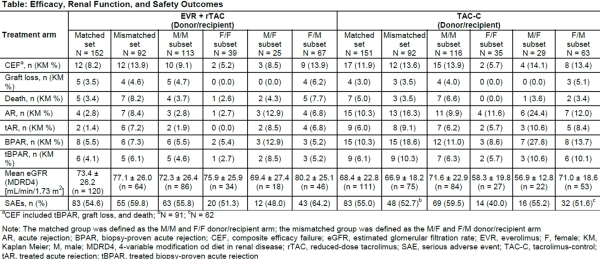Effect of Donor-Recipient Gender Mismatch in Liver Transplant Recipients: A Post-Hoc Analysis of the H2304 Study.
H2304 study group, Hamburg, Germany.
Meeting: 2016 American Transplant Congress
Abstract number: D168
Keywords: Efficacy, Graft failure, Immunosuppression, Liver transplantation
Session Information
Session Name: Poster Session D: Liver: Immunosuppression and Rejection
Session Type: Poster Session
Date: Tuesday, June 14, 2016
Session Time: 6:00pm-7:00pm
 Presentation Time: 6:00pm-7:00pm
Presentation Time: 6:00pm-7:00pm
Location: Halls C&D
Purpose: Donor-recipient gender mismatch may play a role in liver transplant (LTx) outcomes. Here we present the 24-month results from the post-hoc analysis of the H2304 study evaluating the effect of donor-recipient gender matching or mismatching on efficacy, safety, and renal function.
Methods: H2304 (NCT00622869) was a 24-month, multicenter, open-label, randomised controlled study. After 30 days of run-in with tacrolimus (TAC) ± mycophenolic acid, 719 de novo LTxRs were randomized (1:1:1) to receive either everolimus (trough level, C0: 3-8 ng/mL) + reduced TAC (C0: 3-5 ng/mL; EVR + rTAC), EVR (C0: 6-10 ng/mL) + TAC withdrawal at M4 (EVR + TAC-WD), or standard TAC (C0: 6-10 ng/mL; TAC-C) along with steroids. The matched set comprised male/male (M/M) and female/female (F/F) donor/recipient subsets, whereas the mismatched set had male/female (M/F) and female/male (F/M) donor/recipient subsets. Data from the TAC-WD arm are not presented due to early discontinuation of enrolment.
Results: At Month 24, the incidence of composite efficacy failure (CEF), graft loss, biopsy-proven acute rejection (BPAR), and treated BPAR (tBPAR) was lower for the matched vs mismatched sets in both treatment arms. Furthermore, incidence of CEF, death, BPAR, and tBPAR was lower in the F/F subset compared with the M/M, M/F, or F/M subsets in both treatment arms. Female recipients showed no graft loss. Estimated glomerular filtration rate (eGFR) was higher in both matched and mismatched set in EVR + rTAC vs TAC-C arms. Serious adverse events (SAEs) were comparable between the matched and mismatched sets (Table).
Conclusion: As previously observed, gender mismatch has a negative effect on efficacy, however, the best efficacy results were observed in the F/F subset and this finding deserves further interpretation. The influence of gender mismatch on renal function and safety is less evident.
CITATION INFORMATION: Fischer L, de Simone P, Dong G, Lopez P, Bernhardt P, Saliba F. Effect of Donor-Recipient Gender Mismatch in Liver Transplant Recipients: A Post-Hoc Analysis of the H2304 Study. Am J Transplant. 2016;16 (suppl 3).
To cite this abstract in AMA style:
Fischer L, Simone Pde, Dong G, Lopez P, Bernhardt P, Saliba F. Effect of Donor-Recipient Gender Mismatch in Liver Transplant Recipients: A Post-Hoc Analysis of the H2304 Study. [abstract]. Am J Transplant. 2016; 16 (suppl 3). https://atcmeetingabstracts.com/abstract/effect-of-donor-recipient-gender-mismatch-in-liver-transplant-recipients-a-post-hoc-analysis-of-the-h2304-study/. Accessed December 14, 2025.« Back to 2016 American Transplant Congress
